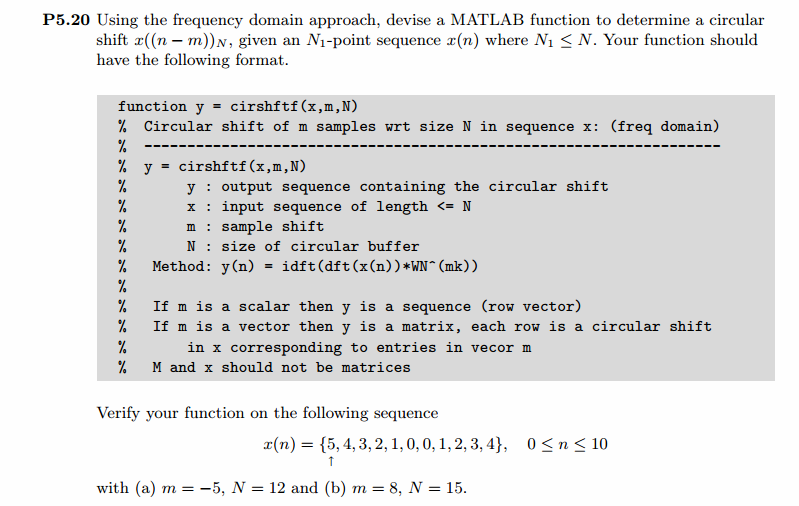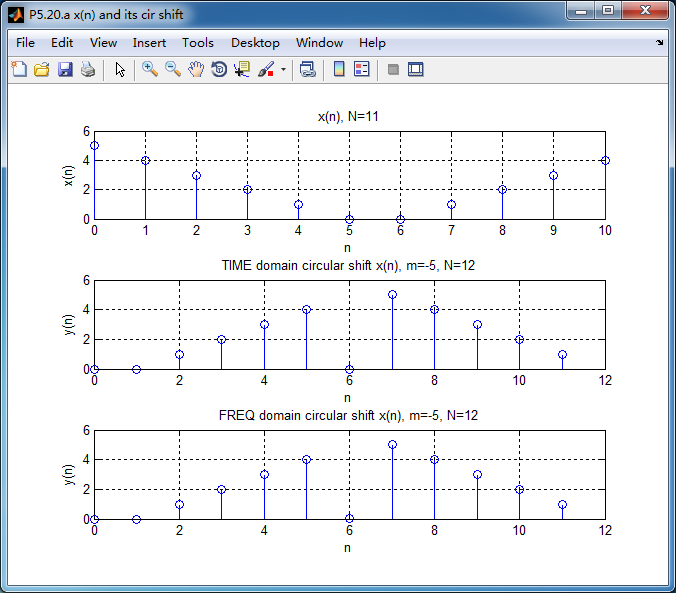窗外的知了叽叽喳喳叫个不停,屋里温度应该有30°,伏天的日子难过啊!

频率域的方法来计算圆周移位
代码:
子函数的
function y = cirshftf(x, m, N)
%% -----------------------------------------------------------------------
% Circular shift of m samples wrt size N in sequence x: (freq domain)
% ---------------------------------------------------------------------
% y = cirshftf(x, m, N)
% y : output sequence containing the circular shift
% x : input sequence of length <= N
% m : sample shift
% N : size of circular buffer
% Method : y(n) = idft( dft(x(n)) * WN ^ (mk))
% if m is a scalar then y is a sequence (row vector)
% if m is a vector then y is a matrix, each row is a circular shift
% in x corresponding to entries in vector m
% M and x should not be matrices
if length(x)>N
error('N must >= length(x)' )
end
x = [x zeros(1, N-length(x))];
k = [0:1:N-1];
WN = exp(-j*2*pi/N);
mk = m*k;
y = real(idft( dft(x, N) .* ( WN .^ (mk) ), N ));
主函数的
%% ++++++++++++++++++++++++++++++++++++++++++++++++++++++++++++++++++++++++++++++++++++++++
%% Output Info about this m-file
fprintf('\n***********************************************************\n');
fprintf(' <DSP using MATLAB> Problem 5.20 \n\n');
banner();
%% ++++++++++++++++++++++++++++++++++++++++++++++++++++++++++++++++++++++++++++++++++++++++
% ---------------------------------------------------------------------------------
% circular shift
% method 1 : cirshftt function, time domain
% method 2 : cirshftf function, freq domain
%
% ---------------------------------------------------------------------------------
n = [0:10];
x = [5, 4, 3, 2, 1, 0, 0, 1, 2, 3, 4]; % N=11 sequence
m1 = -5; N1 = 12;
n1 = [0:N1-1];
m2 = 8; N2 = 15;
n2 = [0:N2-1];
% -----------------------------------------------------
% 1st way to get circular shift---time domain
% -----------------------------------------------------
y1_1 = cirshftt(x, m1, N1);
y2_1 = cirshftt(x, m2, N2);
% --------------------------------------------------------
% 2rd way to get circular shift --- freq domain
% --------------------------------------------------------
y1_2 = cirshftf(x, m1, N1);
y2_2 = cirshftf(x, m2, N2);
figure('NumberTitle', 'off', 'Name', 'P5.20.a x(n) and its cir shift')
set(gcf,'Color','white');
subplot(3,1,1); stem(n, x);
xlabel('n'); ylabel('x(n)');
title('x(n), N=11'); grid on;
subplot(3,1,2); stem(n1, y1_1);
%axis([-N/2, N/2, -0.5, 50.5]);
xlabel('n'); ylabel('y(n)');
title('TIME domain circular shift x(n), m=-5, N=12'); grid on;
subplot(3,1,3); stem(n1, y1_2);
xlabel('n'); ylabel('y(n)');
title('FREQ domain circular shift x(n), m=-5, N=12'); grid on;
axis([0, N1, 0, 6]);
figure('NumberTitle', 'off', 'Name', 'P5.20.b x(n) and its cir shift')
set(gcf,'Color','white');
subplot(3,1,1); stem(n, x);
xlabel('n'); ylabel('x(n)');
title('x(n), N=11'); grid on;
subplot(3,1,2); stem(n2, y2_1);
%axis([-N/2, N/2, -0.5, 50.5]);
xlabel('n'); ylabel('y(n)');
title('TIME domain circular shift x(n), m=8, N=15'); grid on;
subplot(3,1,3); stem(n2, y2_2);
xlabel('n'); ylabel('y(n)');
title('FREQ domain circular shift x(n), m=8, N=15'); grid on;
axis([0, N2, 0, 6]);
运行结果:

